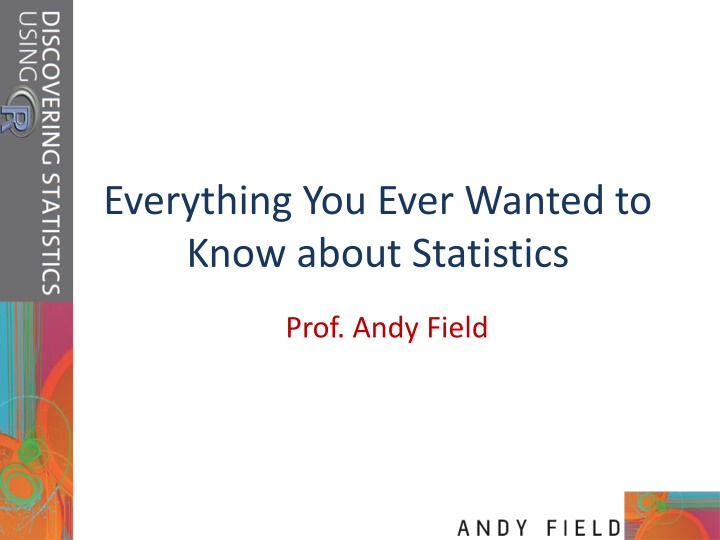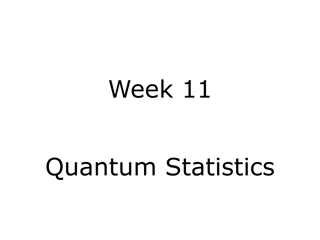Everything You Ever Wanted to Know about Statistics Prof. Andy Field
This content delves into various aspects of statistics, covering topics such as statistical models, mean, fit of a model, standard deviation, populations, samples, and more. Explore the world of statistics through informative slides and explanations provided by Prof. Andy Field.
Download Presentation

Please find below an Image/Link to download the presentation.
The content on the website is provided AS IS for your information and personal use only. It may not be sold, licensed, or shared on other websites without obtaining consent from the author.If you encounter any issues during the download, it is possible that the publisher has removed the file from their server.
You are allowed to download the files provided on this website for personal or commercial use, subject to the condition that they are used lawfully. All files are the property of their respective owners.
The content on the website is provided AS IS for your information and personal use only. It may not be sold, licensed, or shared on other websites without obtaining consent from the author.
E N D
Presentation Transcript
Everything You Ever Wanted to Know about Statistics Prof. Andy Field
Aims and Objectives Know what a statistical model is and why we use them. The mean Know what the fit of a model is and why it is important. The standard deviation Distinguish models for samples and populations Slide 2
Populations and Samples Population The collection of units (be they people, plankton, plants, cities, suicidal authors, etc.) to which we want to generalize a set of findings or a statistical model Sample A smaller (but hopefully representative) collection of units from a population used to determine truths about that population
The Only Equation You Will Ever Need Slide 6
A Simple Statistical Model In statistics we fit models to our data (i.e. we use a statistical model to represent what is happening in the real world). The mean is a hypothetical value (i.e. it doesn t have to be a value that actually exists in the data set). As such, the mean is simple statistical model. Slide 7
The Mean The mean is the sum of all scores divided by the number of scores. The mean is also the value from which the (squared) scores deviate least (it has the least error). n x = mean ( ) X i = 1 i n Slide 8
The Mean: Example Collect some data: 1, 3, 4, 3, 2 Add them up: n = i = + + + + = 1 3 4 3 2 13 ix 1 Divide by the number of scores, n: = 13 5 n x = = 2.6 X i = 1 i n Slide 9
The mean as a model ( ) = + outcome model error i i ( ) 2.6 error + = = + outcome error X lecturer1 lecturer1 1 lecturer1 Slide 10
Measuring the Fit of the Model The mean is a model of what happens in the real world: the typical score. It is not a perfect representation of the data. How can we assess how well the mean represents reality? Slide 11
A Perfect Fit 6 5 Rating (out of 5) 4 3 2 1 0 0 1 2 3 4 5 6 Rater Slide 12
Calculating Error A deviation is the difference between the mean and an actual data point. Deviations can be calculated by taking each score and subtracting the mean from it: = deviation ix x Slide 13
Use the Total Error? We could just take the error between the mean and the data and add them. Score Mean Deviation 1 2.6 -1.6 2 2.6 -0.6 3 2.6 0.4 3 2.6 0.4 4 2.6 1.4 Total = 0 = ( ) 0 X X Slide 15
Sum of Squared Errors We could add the deviations to find out the total error. Deviations cancel out because some are positive and others negative. Therefore, we square each deviation. If we add these squared deviations we get the sum of squared errors (SS). Slide 16
Squared Deviation Score Mean Deviation 1 2.6 -1.6 2.56 2 2.6 -0.6 0.36 3 2.6 0.4 0.16 3 2.6 0.4 0.16 4 2.6 1.4 1.96 Total 5.20 = = 2 SS ( ) 5.20 X X Slide 17
Variance The sum of squares is a good measure of overall variability, but is dependent on the number of scores. We calculate the average variability by dividing by the number of scores (n). This value is called the variance(s2). Slide 18
Degrees of Freedom Sample Population 7 11 8 8 15 12 ? 9 = 10 X = 10 Slide 19
Standard Deviation The variance has one problem: it is measured in units squared. This isn t a very meaningful metric so we take the square root value. This is the standard deviation(s). n ( )2 x x = = = 1.02 s i 5.20 5 = 1 i n Slide 20
Important Things to Remember The sum of squares, variance, and standard deviation represent the same thing: The fit of the mean to the data The variability in the data How well the mean represents the observed data Error Slide 21
Same Mean, Different SD Slide 22
The SD and the Shape of a Distribution
Samples vs. Populations Sample Mean and SD describe only the sample from which they were calculated. Population Mean and SD are intended to describe the entire population (very rare in psychology). Sample to Population: Mean and SD are obtained from a sample, but are used to estimate the mean and SD of the population (very common in psychology). Slide 24
Sampling Variation = 30 X = 30 X = = = 25 33 X X 29 X
Population = 10 M = 10 M = 9 M = 11 M = 10 s M = 9 M = 8 M = 12 X= M = 11 M = 10 N Mean = 10 SD = 1.22 4 3 Frequency 2 1 0 6 7 8 9 10 11 12 13 14 Sample Mean
Confidence Intervals Domjan et al. (1998) Conditioned sperm release in Japanese quail. True mean 15 million sperm Sample mean 17 million sperm Interval estimate 12 to 22 million (contains true value) 16 to 18 million (misses true value) CIs constructed such that 95% contain the true value. Slide 27
Test Statistics A statistic for which the frequency of particular values is known. Observed values can be used to test hypotheses.
Type I and Type II Errors Type I error occurs when we believe that there is a genuine effect in our population when, in fact, there isn t. The probability is the -level (usually .05) Type II error occurs when we believe that there is no effect in the population when, in reality, there is. The probability is the -level (often .2)
What Does Statistical Significance Tell Us? The importance of an effect? No, significance depends on sample size. That the null hypothesis is false? No, it is always false. That the null hypothesis is true? No, it is never true.
Effect Sizes An effect size is a standardized measure of the size of an effect: Standardized = comparable across studies Not (as) reliant on the sample size Allows people to objectively evaluate the size of observed effect. Andy Field PG Stats
Effect Size Measures r = .1, d = .2 (small effect): the effect explains 1% of the total variance. r = .3, d = .5 (medium effect): the effect accounts for 9% of the total variance. r = .5, d = .8 (large effect): the effect accounts for 25% of the variance. Beware of these canned effect sizes though: The size of effect should be placed within the research context. Andy Field PG Stats
Effect Size Measures There are several effect size measures that can be used: Cohen s d Pearson s r Glass Hedges g Odds ratio/risk rates Pearson s r is a good intuitive measure Oh, apart from when group sizes are different Andy Field PG Stats























